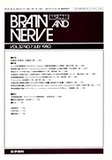Japanese
English
- 有料閲覧
- Abstract 文献概要
- 1ページ目 Look Inside
I.はじめに
Loomis (1973)8)およびDavis (1939)ら2)によつて,脳波におけるK-complexが報告されて以来,この現象は2つの方面から注目されている。その1つは,中枢機能に関する神経生理学的方面1,3,5,8,11,17)からであり,他の1つは,臨床的にK-complexを指標として聴力検査17,20,23)に応用しようとするものである。
これまでK-complexと聴性誘発電位(auditory evo—ked potential,以下AEPと呼ぶ)との関係を指摘したもの3,11,15)はあるが,詳しい解析はなされていない。
For this study, sleep EEG of eleven healthyadult subjects ranged from 25 to 30 years of age were observed during stage 3 and evoked K-complex and AEP were both concordantly recorded to investigate the correlation between latencies of s-components in the K-complexes and N4-components in the AEPs during stage 3.
The results obtained were as follow:
(1) Three distinct components of K-complex such as sharp wave, slow wave (s-component) and burst wave of 12-14 c/sec were found almost constantly during stage 3.
(2) It can be concluded that the evoked K-complexes (s-components) in the EEG were almost equivalent to the AEPs (N4-components) if both were concordantly recorded time-locked to click stimuli which were presented every 10 sec with 15 decibels during stage 3.
(3) S-component of K-complex such as slow wave was attributed to the impulse bombardment of the nucleus reticularis thalami which is a frequency gate following the hypothesis of Scheibel, M. E. and Scheibel, A. B..18 19)

Copyright © 1980, Igaku-Shoin Ltd. All rights reserved.


